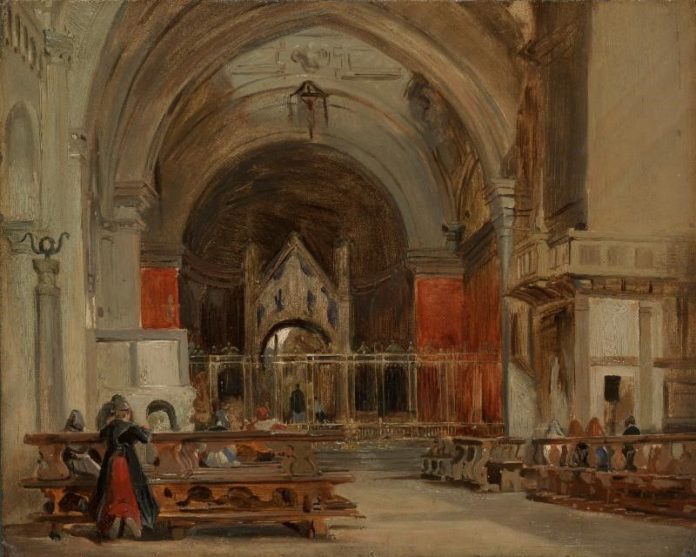The Kimbell Art Museum announced today it has discovered and acquired a rare oil sketch by the English artist Richard Parkes Bonington (1802–1828), The Interior of San Ambrogio, Milan, 1826.
This work joins The Grand Canal, Venice, Looking Toward the Rialto, one of the artist’s rare oil sketches of that city, which was purchased by the Kimbell in 2009. Both are on view now in the Kahn Building’s north galleries in the permanent collection.
According to a Kimbell news release, fortuitous circumstances led to the identification of The Interior of San Ambrogio, Milan as a work by Bonington. Until last summer, it was believed to be the work of the Scottish painter David Roberts (1796–1864). Roberts is known for his picturesque sketches of sites in Britain, the Continent and especially the Middle East. The picture bore Roberts’s signature and the date 1841 and was sold, according to a Christie’s number on the painting’s reverse, as a David Roberts titled “Serving Mass” at Christie’s, London, in 1946. A label on the painting records that it appeared at auction again in 1995, in Stockholm. It was later acquired by a Texas collector, who in 2003 consigned it to auction in New Orleans as David Roberts’s “Interior of Cathedral.” Unsold, it was purchased the following year by another Texas collector, Mac Shafer of Mineral Wells.
Last summer, Shafer showed the painting to Eric M. Lee, director of the Kimbell, and deputy director George T. M. Shackelford. Several days later, in an unrelated research, Shackelford came across an image of an almost identical composition—-a watercolor not by Roberts but by Bonington in The Wallace Collection, in London.
That was followed by more research, in consultation with leading Bonington expert Patrick Noon, who earlier had written that The Wallace Collection watercolor was presumably based on an untraced Bonington oil sketch. Examination of Shafer’s painting by Kimbell director of conservation Claire Barry and comparison of x-radiographs of the Milanese oil sketch with the Kimbell’s Venetian view by Bonington, The Grand Canal, Venice, Looking Toward the Rialto, revealed similar techniques and handling of brushstrokes.
Bonington did not sign his oil sketches, and it was determined that the signature and date had been added at a later time on top of the varnish, after the painting’s identification with Bonington had been lost, and possibly by a dealer who thought the picture might have been by Roberts, who painted similar church interiors. Bonington was better known for his coastal scenes and views of Venice. When Barry cleaned the painting, the spurious Roberts signature was removed, along with the layers of discolored varnish. The striking, on-site oil sketch was in fact an autograph painting by Bonington, which no doubt had been sold in the artist’s 1829 studio sale after his death from tuberculosis one month shy of his 26th birthday.
“The odds that this work would be rediscovered as one of the extremely rare paintings by Boninton are one in a million,” said the Kimbell’s Lee.
Bonington was a gifted British landscape painters, comparable in artistic stature to J. M. W. Turner and John Constable but less familiar because he died young and left only a small body of work. He was a remarkable figure, not least in bridging the very separate artistic worlds of Britain and France where he shared a studio with Delacroix, and he enjoyed considerable success in both countries despite his youth. Displayed together, the two Kimbell sketches offer complementary examples of Bonington’s deft touch: the penumbral shadows of the church interior and the atmospheric transparency of the Venetian view.
Bonington traveled to Italy for the first time in the spring of 1826. This is one of the first paintings he produced while there, on or about April 11. His traveling companion wrote: “We are in Milan, where at last we have unpacked and put to use our color boxes. We have painted the interior of the cathedral, nocturnal effect, and I think that if Bonington can produce the paintings he has sketched his reputation will be made.”
Like the view of The Grand Canal, this sketch was painted on-site, the oil colors applied with skill and speed in the presence of the motif. Later, back home in Paris, Bonington would use both sketches as the models for further works. The Venetian view, with boats and figures added, served as the basis for a smaller oil painting (National Gallery of Art, Washington, D.C.), while this Milanese sketch was copied in a highly finished watercolor, in which the figures were positioned differently. True to predictions, the finished paintings produced from his Italian sketches made Bonington’s reputation in the 19th century; in modern times his sketches are equally—-if not more—-admired.
www.kimbellart.org/






